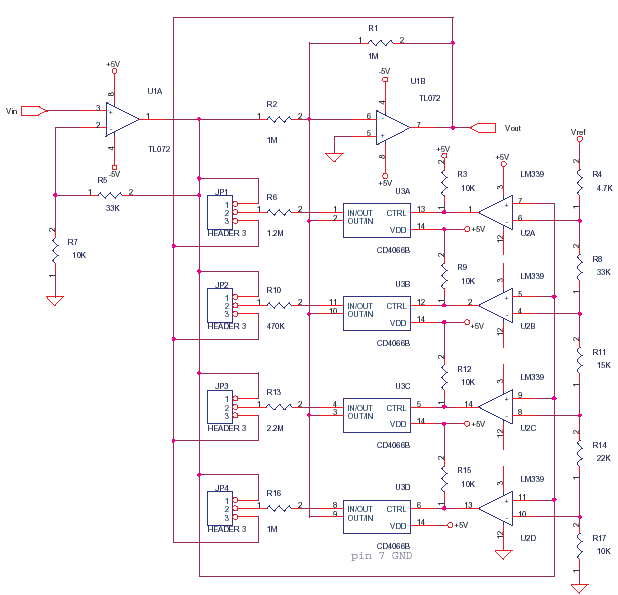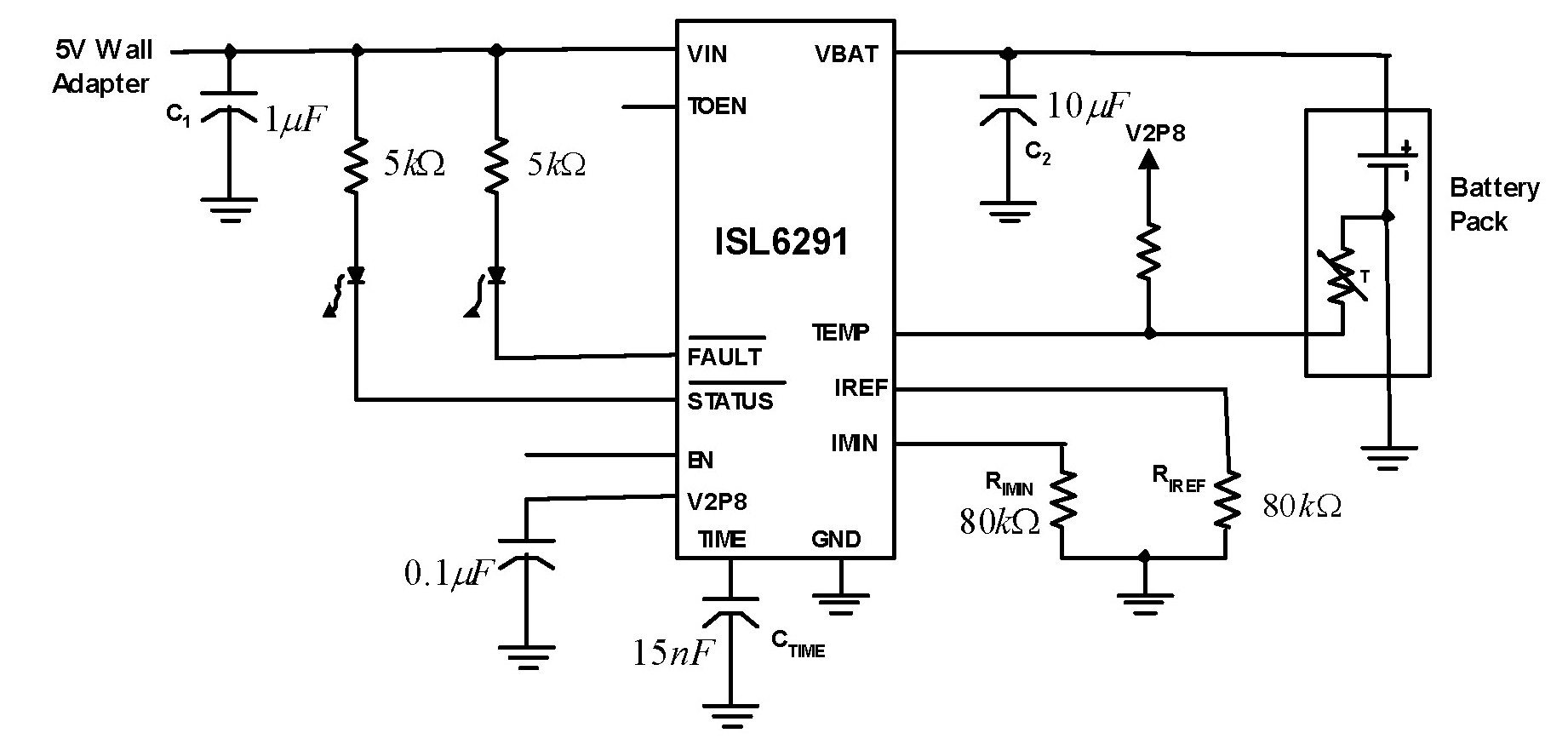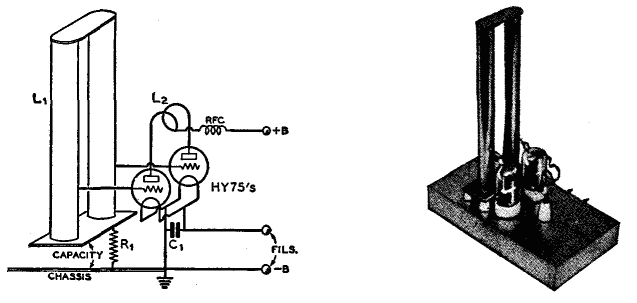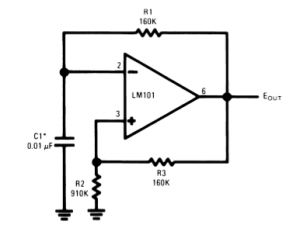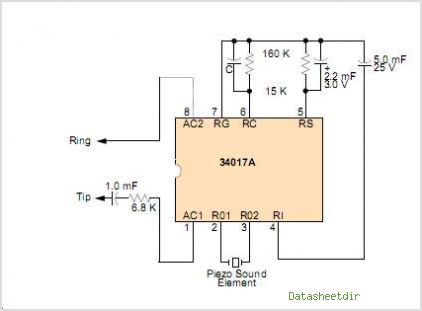
Linear temperature-to-frequency
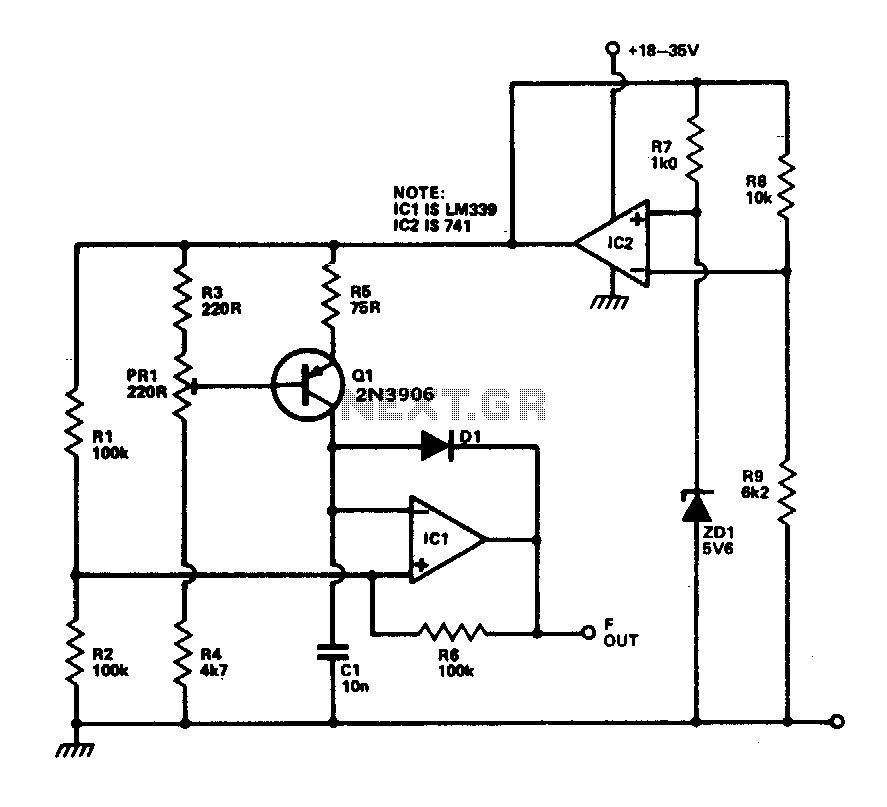
This circuit provides a linear frequency increase of 10 Hz per °C over a temperature range of 0 to 100 °C and can be utilized with logic systems, including microprocessors. The temperature probe Q1, utilizing the Vbe characteristic, changes by 2 mV per °C. This transistor is part of a constant current source circuit, allowing for a current that is proportional to temperature, which is used to charge capacitor C1. The circuit is powered by a temperature-stable reference voltage supplied by the operational amplifier 741. Additionally, comparator IC1 functions as a Schmitt trigger, with its output used to discharge capacitor C1 through diode D1. To calibrate the circuit, Q1 is immersed in boiling distilled water, and potentiometer PR1 is adjusted to achieve a 1 kHz output. The prototype has demonstrated an accuracy within ±0 °C.
The described circuit operates by converting temperature variations into a corresponding frequency output, which can be effectively interfaced with digital systems. The linear frequency response of 10 Hz per °C makes it suitable for applications that require precise temperature monitoring and control. The temperature probe Q1, based on the bipolar junction transistor (BJT) principle, exploits the relationship between base-emitter voltage (Vbe) and temperature, where the Vbe decreases approximately 2 mV for each degree Celsius increase in temperature.
In this configuration, the constant current source maintains a steady current that flows through the temperature probe, ensuring that the voltage across it accurately reflects the temperature. Capacitor C1 serves as a timing element in conjunction with the Schmitt trigger, which provides hysteresis to the output signal, thus preventing noise from causing false triggering. The use of the 741 operational amplifier as a reference voltage source enhances the stability of the circuit, ensuring that variations in supply voltage do not affect the accuracy of the temperature readings.
The calibration process is critical for ensuring the accuracy of the circuit. By submerging Q1 in boiling distilled water, the output frequency can be set to a known reference point (1 kHz), allowing PR1 to be fine-tuned accordingly. This step ensures that the system can provide reliable temperature readings across the specified range. The inclusion of diode D1 allows for the rapid discharge of capacitor C1, which is essential for maintaining the responsiveness of the circuit to temperature changes.
Overall, this circuit design is advantageous for applications in environmental monitoring, industrial automation, and other fields where precise temperature measurement is crucial. Its integration with microprocessors and logic systems further enhances its versatility and usability in modern electronic systems.This circuit provides a linear increase of frequency of 10 Hz/°C over 0-100 °C and can thus be used with logic systems, including microprocessors. Temperature probes Ql Vbe changes 2 mV/°C. This transistor is incorporated in a constant current source circuit. Thus, a current proportional to temperature will be available to charge Cl. The circuit is powered via the temperature stable reference voltage supplied by the 741 Comparator ICl is used as a Schmitt trigger whose output is used to discharge Cl via Dl. To calibrate the circuit Ql is immersed in boiling distilled water and PR1 adjusted to give 1 kHz output. The prototype was found to be accurate to within 0 °C. 🔗 External reference
The described circuit operates by converting temperature variations into a corresponding frequency output, which can be effectively interfaced with digital systems. The linear frequency response of 10 Hz per °C makes it suitable for applications that require precise temperature monitoring and control. The temperature probe Q1, based on the bipolar junction transistor (BJT) principle, exploits the relationship between base-emitter voltage (Vbe) and temperature, where the Vbe decreases approximately 2 mV for each degree Celsius increase in temperature.
In this configuration, the constant current source maintains a steady current that flows through the temperature probe, ensuring that the voltage across it accurately reflects the temperature. Capacitor C1 serves as a timing element in conjunction with the Schmitt trigger, which provides hysteresis to the output signal, thus preventing noise from causing false triggering. The use of the 741 operational amplifier as a reference voltage source enhances the stability of the circuit, ensuring that variations in supply voltage do not affect the accuracy of the temperature readings.
The calibration process is critical for ensuring the accuracy of the circuit. By submerging Q1 in boiling distilled water, the output frequency can be set to a known reference point (1 kHz), allowing PR1 to be fine-tuned accordingly. This step ensures that the system can provide reliable temperature readings across the specified range. The inclusion of diode D1 allows for the rapid discharge of capacitor C1, which is essential for maintaining the responsiveness of the circuit to temperature changes.
Overall, this circuit design is advantageous for applications in environmental monitoring, industrial automation, and other fields where precise temperature measurement is crucial. Its integration with microprocessors and logic systems further enhances its versatility and usability in modern electronic systems.This circuit provides a linear increase of frequency of 10 Hz/°C over 0-100 °C and can thus be used with logic systems, including microprocessors. Temperature probes Ql Vbe changes 2 mV/°C. This transistor is incorporated in a constant current source circuit. Thus, a current proportional to temperature will be available to charge Cl. The circuit is powered via the temperature stable reference voltage supplied by the 741 Comparator ICl is used as a Schmitt trigger whose output is used to discharge Cl via Dl. To calibrate the circuit Ql is immersed in boiling distilled water and PR1 adjusted to give 1 kHz output. The prototype was found to be accurate to within 0 °C. 🔗 External reference
